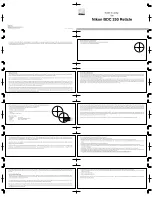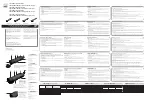
your latitude is 35° North, set the pointer to +35. The latitude
setting should not have to be adjusted again unless you move
to a different viewing location some distance away.
3.
Loosen the Dec. lock lever and rotate the telescope optical
tube until it is parallel with the R.A. axis. The pointer on the
Dec. setting circle should read 90°. Retighten the Dec. lock
lever.
4.
Move the tripod so the telescope tube (and R.A. axis) points
roughly at Polaris. If you cannot see Polaris directly from your
observing site, consult a compass and rotate the tripod so the
telescope points north. There is a label bearing a large “N” at
the base of the equatorial mount (Figure 7). It should be fac-
ing north.
The equatorial mount is now approximately polar-aligned for
casual observing. More precise polar alignment is required for
astrophotography and for use of the manual setting circles.
From this point on in your observing session, you should not
make any further adjustments to the latitude of the mount,
nor should you move the tripod. Doing so will undo the polar
alignment. The telescope should be moved only about its R.A.
and Dec. axes.
the Polar axis Finder scope
A feature of the AstroView 6 EQ is the polar axis finder scope
housed inside the R.A. axis of the equatorial mount (see
Figure 8). When properly aligned and used, it makes accurate
polar alignment quick and easy to do. Alignment of the polar
finder need only be done once, unless it gets bumped or oth-
erwise shifts its position.
Remove the cover cap from the front opening in the R.A. axis
of the mount (see Figure 5). Look through the polar finder at
a distant object. Focus the polar finder so that the images and
reticle are sharp by rotating the eyepiece end of the finder.
Notice that the reticle pattern consists of a crosshair with a
circle around the middle. On the circumference of this circle
is a tiny circle; this is where Polaris will be placed for accurate
polar alignment once the finder is properly aligned. Alignment
of the polar finder is best done during the day, before going
out into the field at night.
aligning the Polar axis Finder scope
Aligning the polar axis finder scope so that it will accurately
point at the true north pole is a two-step procedure. First, the
polar finder must be rotated in its housing so that the small
circle in which Polaris will be placed in is in the proper initial
position. Next, the polar axis finder must be adjusted so that it
points directly along the mount’s R.A. axis.
We will start by aligning the polar finder rotationally. Refer to
Figure 8.
1.
Loosen the R.A. setting circle lock thumb screw, located just
above the R.A. setting circle (see Figure 5). Rotate the R.A.
setting circle until the line above the “0” on the setting circle
lines up with the pointed indicator that is cast into the mount
(located directly below the large thumbscrew; see Figure 8).
Retighten the thumbscrew.
2.
Rotate the date circle until the “0” line on the meridian off-
set scale lines up with the time meridian indicator mark. The
meridian offset scale is printed on the inner circumference of
the date circle, and is labeled “E20” to “W20”. The time merid-
ian indicator mark is an engraved line on the exterior of the
polar finder’s housing. It is on the “ring” of the housing that is
closest to the date circle.
3.
The R.A. setting circle is labeled in hours, from “0” to “23”
(military time). For Northern Hemisphere observers, refer to
the top numbers on the setting circle. Each small line repre-
sents 10 minutes of R.A. The date circle is labeled from “1” to
“12”, with each number representing a month of the year (“1”
is January, “2” is February, etc.). Each small line represents a
two-day increment.
8
Figure 7.
For polar alignment, position the tripod so that the “N”
label at the base of the mount faces north. The two azimuth fine
adjustment knobs above it are used to make small adjustments to the
mount’s azimuth position.
Azimuth
fine
adjustment
knobs
Tripod
attachment
knob
Pointer
R.A. setting circle
Meridian
offset scale
Polar scope
housing
Polar axis
finder scope
Figure 8.
The polar axis finder scope installed in the right ascension
(R.A.) axis of the mount.
Date circle
Ring with
engraved time
meridian indicator
mark
Polar scope
alignment
thumbscrew (3)





























